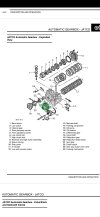I know nothing about how automatic gearboxes work internally. Presumably that No. 17 is some part of that!
What I do know though, is that "the differential", which splits drive between the front wheels is most definitely in the IRD. That is the same for all Freelanders regardless of petrol/diesel or manual/auto.
Your problem though is not with the differential inside the IRD. If the LH drive shaft connection is wobbly or loose, that connection/join is past the differential is the drive train. If you look at this pic of an IRD...
The IRD is rotated 90 degrees from its normal orientation in this pic, the 'back' of it is pointing upwards. The big black flange at the top is where the prop shaft bolts to to drive the rear axle.
There are 2 splines on the left, these slot into the gearbox. The larger splines take power from the gearbox, it is on the input shaft that goes into the IRD. This input shaft has gears on it to provide a direct drive to that black flange and further along goes into "the differential" which is at the RH end of the IRD in that pic. The RH drive shaft plugs in to the IRD at the RH side of this pic, basically straight into the diff. The LH output from the diff drives another shaft that turns inside the input shaft and exits the IRD at those smaller splines on the left.
Those smaller splines connect to another shaft that goes through the gearbox and the LH drive shaft plugs into that. It will be this shaft that has play on the LH drive shaft connection.
I don't know how easy it is to replace the bearings supporting this shaft.
I know that when the inner CV wears on the RH drive shaft, this can/will lead to wear on the bearings supporting the drive shaft meaning the RH connection is loose/wobbly and can cause the diff to jam and shatter the IRD casing. I would therefore think it highly likely that if the LH drive shaft inner CV wear, it to could cause excessive wear on the bearings supporting that shaft travelling through the gearbox from those smaller splines. I would have thought actually that it was more likely for the LH side to wear as the drive shaft is shorter and therefore the angles the CV is working at are more acute. That would be very much exaggerated if the car has had 'a lift'.
I don't really know if you would be better off trying to repair these bearings on the replacement box, or using parts from the replacement box to fix your original. I'm sorry, all I can offer is advice, not solutions!
You definitely made a good call not going cheap on the new drive shaft - so long as it is a genuine GKN shaft.



